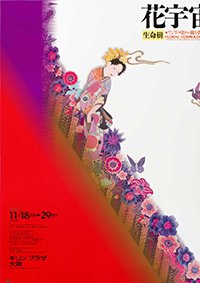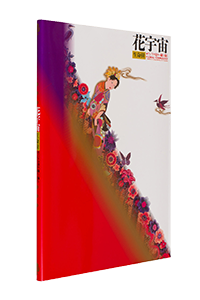Floral Cosmology
Traditions in Dyeing, Weaving, and Ornaments
Exhibition

The exhibition organizers searched for images of the “tree of life”—which appears at times vividly and at times surreptitiously in the modern lives of people in Asia—in Asian dyed works, textiles, ornaments, crowns and festival tools, and tools for everyday living. Then they attempted to decode the meanings and ideas these images signify. From August to November 1992 the exhibition toured four cities as part of the “Southeast Asian Festival ’92,” a large festival presenting a comprehensive showcase of Southeast Asian culture.
| Dates & Venue (Fukuoka) |
August 11–23, 1992 |
|---|---|
| Fukuoka City Museum | |
| (Tokyo) | September 13–24, 1992 |
| Laforet Museum, Harajuku | |
| (Hiroshima) | September 30–October 5, 1992 |
| Alpark Tenmaya, Hiroshima | |
| (Osaka) | November 18–29, 1992 |
| Kirin Plaza Osaka | |
| Supervisors | Sugiura Kohei (Graphic Designer) |
| Organizers | The Southeast Asian Festival '92 Executive Committee; The Japan Foundation; Tokyo Metropolitan Government; Tokyo Metropolitan Culture Foundation; The Southeast Asian Festival '92 Osaka Steering Committee; The Asian Exchange Promotion Executive Committee; Fukuoka City Government; Fukuoka International Association; Asian Month Committee; Laforet HARAJUKU*; Fukuoka City Museum**; Kirin Plaza Osaka*** *Tokyo only **Fukuoka only ***Osaka only |
| Support | The Ministry of Foreign Affairs; The Embassy of Brunei; The Embassy of Indonesia; The Embassy of Malaysia; The Embassy of the Philippines; The Embassy of Singapore; The Embassy of Thailand; NHK |
| Cooperation | NHK Enterprises; Toppan Printing; Tokyo Studio; TL Yamagiwa Laboratory; Imejirando Harajuku; Tanakaya; Yamato Transport; Yasuda Fire and Marine Insurance |
| Notes | Southeast Asian Festival ’92 |
Catalogue

Floral Cosmology: Traditions in Dyeing, Weaving and Ornaments
Supervised by Sugiura Kohei; Goto Tamon
- Publisher:
Tokyo: NHK Enterprises
- Year:
1992
- Total Number of Pages:
128
- Size:
30 cm
- Language:
Japanese (jpn)
- NCID:
BN11539301
[Contents]
| p. 11 | Hito ga ki to nari, hana to naru [Humans Become the Tree, and Also the Flower] |
| p. 12 | Hana monyo, ki monyo [Floral Pattern, Tree Pattern] |
| p. 16 | 1. Hana o kiru, hana o matou [Wearing Flowers, Dressed in Flowers] |
| p. 58 | 2. Hana saku ki ga kataru mono [What the Blooming Trees Tell Us] |
| p. 76 | 3. Hana o kamuru, hana o kazaru [Putting on Flowers, Decorating Flowers] |
| p. 89 | Kagayaku hana, uchu no hana [Shining Flowers, Flowers of the Universe] |
| p. 91 | Ki, kagiri nashi sono megumi [Tree, the Endlessly Fruitful] |
| p. 95 | Jumoku to yama no tasai na hengen [The Multifarious Transformations of Trees and Mountains] |
| p. 100 | Seimei no ki no imi kukan [The Spatial Meaning of the Tree of Life] |
| p. 104 | Tai ni okeru seimei no ki [The Tree of Life in Thailand] |
| p. 112 | Baishi Sukuan e no tabi [Journey to Baci Soukhuan] |
| p. 116 | Ki ni naru, hana to kasu [Becoming the Tree, and Also the Flower] |
| p. 120 | Zuisho no hana, junkan suru seimei [The Flower from Zuisho and Circulation of Life] |
| p. 126 | Sanko bunken [Bibliography] |
What We Do
- What We Do Top
- Arts and Cultural Exchange [Culture]
- Japanese-Language Education Overseas [Language]
- Japanese-Language Education Overseas [Language] Top
- Learn Japanese-language
- Teach Japanese-language
- Take Japanese-Language Test
- Know about Japanese-language education abroad
- The Japanese-Language Institute, Urawa
- The Japanese-Language Institute, Kansai
- Japanese-Language Programs for Foreign Specified Skilled Worker Candidates
- Japanese Language Education for Japanese Children Resident Overseas and for the Descendants of Migrants
- Archives
- Japanese Studies and Global Partnerships [Dialogue]
- JF digital collection
- Other Programs / Programs to Commemorate Exchange Year
- Awards and Prizes
- Publications
